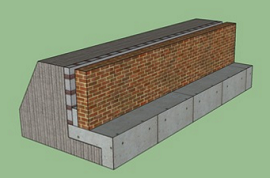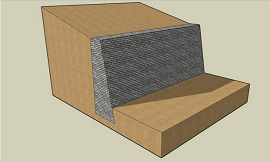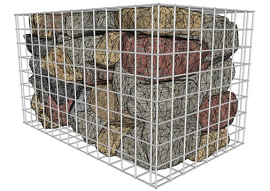Retaining walls
Contents |
[edit] Introduction
Retaining walls are vertical or near-vertical structures designed to retain material on one side, preventing it from collapsing or slipping or preventing erosion. They provide support to terrain where the soil’s angle of repose is exceeded and it would otherwise collapse into a more natural form. The principal characteristic of a retaining wall is being able to withstand the pressure exerted by the retained material, which is usually soil.
Retaining walls may include a parapet that extends above the height of the retained material, often for safety reasons.
The main uses of retaining walls are to help prevent soil erosion, create usable beds out of steep terrain and to provide decorative or functional landscaping features. They may be independent structures, or may be part of a wider construction works, such as a building.
Planning permission is required if the wall is to be over 1-metre high and next to a road or pathway; or over 2-metres high elsewhere. Independent, freestanding retaining walls may not require building regulation approval; however, any structures must be structurally sound and well maintained.
According to the Deputy Director of the Building Regulations and Standards Division at DCLG, “Where they consider that a building or structure, or part of it, is in such a state or is used to carry such loads as to be dangerous, local authorities have powers under sections 77 and 78 of the Building Act 1984 to take action to remove danger to the public. The exercise of such action may be appropriate for freestanding boundary and retaining walls that present a danger.” Ref Construction and maintenance of boundary and retaining walls, 13 May 2013.
Where a retaining wall is near to a boundary, it may be subject to the provisions of the Party Wall Act, and may be required to continue a right of support.
[edit] Earth pressure
There are three types of earth pressure that bear upon the movement of the wall, that were investigated by Terzaghi in 1929:
- Earth pressure at rest: This applies when the wall is at rest and the material is in its natural state.
- Active earth pressure: As the wall moves away from the backfill, there is a decrease in the pressure on the wall which continues until reaching a minimum value that then remains constant.
- Passive earth pressure: As the wall moves towards the backfill, there is an increase in the pressure on the wall which continues until reaching a maximum value that then remains constant.
[edit] Hydrostatic pressure
Water can also build up behind retaining walls, increasing the pressure on them, and so they may include weep holes or some other form of drainage. Accumulating water can also reduce the stability of retained soil, and the friction between the retaining wall base and the soil beneath it.
[edit] Types of retaining wall
Very broadly, retaining walls are ‘cut’ walls, in which the wall is cut into the existing slope, and ‘fill’ walls in which the retaining wall is built in front of the slope, and then the space behind It is filled.
There a wide variety of types of retaining wall:
[edit] Gravity retaining wall
This type of wall depends on its mass to retain the material behind it and remain stable. Stone, concrete and brick masonry are the most common materials used in this type of wall construction. To maintain stability, the mass and friction of the interlocking wall materials must be greater than the force of the material being retained. Gravity walls might be suitable for heights of up to 2 to 3m
To better resisting pressure gravity retaining walls may have a ‘battered’ profile, (that is one face is sloping so that the wall is thicker at the bottom than the top. Either the face or the back of the wall may be battered. Very broadly, the base should be half to three-quarters of the wall’s height.
[edit] Sheet piling wall
This type of wall can be made of timber, interlocking steel or vinyl panels, that have been driven into the ground up to the required depth and fixed in place by soil on either side at the base. These are most commonly used where the soil is soft and the space available is restricted. As a general rule, there is usually 1/3 of the pile above ground and 2/3 below ground. The piles must resist the bending forces induced by the retained material.
Concrete pile walls can be used to create permanent or temporary retaining walls. They are formed by placing piles directly adjacent to one another. These can be; closely-spaced contiguous pile walls, or interlocking secant walls, which depending on the composition of the secondary intermediate piles can be hard/soft, hard/firm or hard/hard secant walls.
[edit] Reinforced retaining wall
The stability of reinforced concrete and masonry walls can be increased by reinforcement bars.
Cantilever retaining walls, made of steel-reinforced or cast-in-place concrete, are connected to a slab foundation (in the shape of an inverted ‘T’ or ‘L’) which allows horizontal pressures from behind the wall to be converted to vertical pressures on the ground below.
Counterfort buttresses, spaced at equal distances along the wall can be used to create the structural path between the vertical wall and the horizontal base. These are typically used for walls with heights greater than 8-12 m.
[edit] Mechanical stabilisation
Mechnically stabilised earth (MSE) walls are walls that can tolerate some differential movement. The wall face is infilled with granular soil whilst retaining the backfill soil. The advantage of MSE walls is the ease of construction, as they do not require formwork or curing.
The use of soil nailing in MSE walls, involves introducing slender steel reinforcing bars to the soil, placed parallel to one another on a slight incline and grouted into place.
[edit] Anchored earth walls
Anchored earth walls include cables or rods anchored in the rock or soil behind the wall. Concrete is injected at the end of the rod to bind it into the soil. This method can be used where high loads are to be expected.
[edit] Gabions
Gabions are cages, baskets or boxes typically made of wire, filled with earth, sand, crushed rock and so on. They may be woven, or welded. As they are free-draining retaining structures they are frequently used where water will be present, such as along coastal roads and as flood defences.
[edit] Crib walls
Where timber, steel or concrete cages or boxes are interlocking, this may be described as a crib wall.
[edit] Green retaining walls
Green retaining walls can be used to retain more gentle slopes. A geocellular structure such as a series of ‘honeycomb’ cells can be embedded into the surface of the slope to stabilise it, and the individual cells can then be planted.
[edit] Barrette retaining wall
A barrette retaining wall is constructed from reinforced concrete columns of a rectangular plan form with the long axis in the direction of retention.
[edit] Related articles on Designing Buildings
- Caisson.
- Coastal defences.
- Cofferdam.
- Continuous flight auger piles.
- Diaphragm wall.
- Driven piles.
- Foundations.
- Groundworks.
- Ground anchor.
- Grouting in civil engineering.
- Hesco barrier.
- Micropiles.
- Pile foundations.
- Pile wall.
- Prestressed concrete.
- Preventing wall collapse.
- Sheet piles.
- Shoring.
- Sleeper wall.
- Soil nailing.
- Structural engineer.
- Temporary works.
- Underpinning.
- Vibro-compaction.
- Vibro-replacement.
[edit] External references
- About Civil - Retaining walls
- Planning Portal - Fences, walls, gates
Featured articles and news
RTPI leader to become new CIOB Chief Executive Officer
Dr Victoria Hills MRTPI, FICE to take over after Caroline Gumble’s departure.
Social and affordable housing, a long term plan for delivery
The “Delivering a Decade of Renewal for Social and Affordable Housing” strategy sets out future path.
A change to adoptive architecture
Effects of global weather warming on architectural detailing, material choice and human interaction.
The proposed publicly owned and backed subsidiary of Homes England, to facilitate new homes.
How big is the problem and what can we do to mitigate the effects?
Overheating guidance and tools for building designers
A number of cool guides to help with the heat.
The UK's Modern Industrial Strategy: A 10 year plan
Previous consultation criticism, current key elements and general support with some persisting reservations.
Building Safety Regulator reforms
New roles, new staff and a new fast track service pave the way for a single construction regulator.
Architectural Technologist CPDs and Communications
CIAT CPD… and how you can do it!
Cooling centres and cool spaces
Managing extreme heat in cities by directing the public to places for heat stress relief and water sources.
Winter gardens: A brief history and warm variations
Extending the season with glass in different forms and terms.
Restoring Great Yarmouth's Winter Gardens
Transforming one of the least sustainable constructions imaginable.
Construction Skills Mission Board launch sector drive
Newly formed government and industry collaboration set strategy for recruiting an additional 100,000 construction workers a year.
New Architects Code comes into effect in September 2025
ARB Architects Code of Conduct and Practice available with ongoing consultation regarding guidance.
Welsh Skills Body (Medr) launches ambitious plan
The new skills body brings together funding and regulation of tertiary education and research for the devolved nation.
Paul Gandy FCIOB announced as next CIOB President
Former Tilbury Douglas CEO takes helm.
UK Infrastructure: A 10 Year Strategy. In brief with reactions
With the National Infrastructure and Service Transformation Authority (NISTA).

























